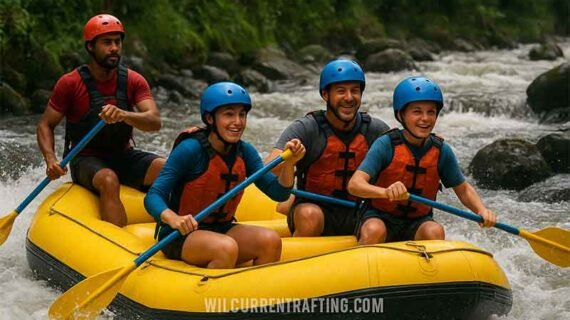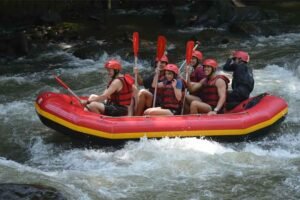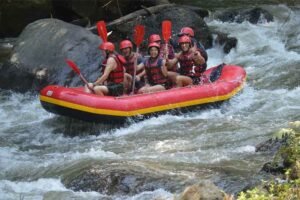White water rafting looks wild and thrilling, but for many first-timers, a big question pops up: is white water rafting dangerous? The short answer is—it can be, but only if you’re not prepared or guided properly. With the right safety measures, rafting is actually one of the safest adventure sports you can try.
In this guide, we’ll break down what makes rafting safe, what risks to know, and how to enjoy it without worry.
What Is White Water Rafting?
White water rafting is an adventure activity where you ride an inflatable raft through river rapids. Rapids are graded from Class I (easy, slow-moving water) to Class V (very intense, expert-only rapids). Most commercial rafting tours around the world, including Bali’s Ayung River, operate between Class II and Class III, which are safe for beginners and families.
The thrill comes from navigating waves, drops, and splashes, but with professional guides steering, it’s far less dangerous than it looks.
So, Is White Water Rafting Dangerous?
The risk depends on three main factors: river difficulty, safety gear, and your rafting operator.
- River difficulty: Beginners are never taken to extreme rapids. Family-friendly tours stick to moderate sections.
- Safety gear: Helmets and life jackets are non-negotiable. Modern equipment is designed to keep you safe even if you fall out.
- Guides: Experienced rafting guides know how to read the river and handle emergencies. A good guide is your biggest safety guarantee.
According to outdoor safety reports, rafting accidents are far less common than accidents in hiking, skiing, or even cycling. When you go with a licensed operator, the activity is considered low-risk.
Common Myths About Rafting Safety
1. “I can’t swim, so rafting isn’t safe for me”
Not true. You’ll wear a life jacket that keeps you afloat, and guides will teach you how to float safely if you fall in. Many non-swimmers raft without issues.
2. “Rafting is only for adrenaline junkies”
Wrong again. There are different types of rafting trips, from calm family floats to thrilling rapids. If you’re unsure, start with family rafting in Ubud.
3. “The raft will flip easily”
Modern rafts are extremely stable. Flips are rare on beginner-friendly rivers, and even if it happens, guides are trained to handle it quickly.
Real Risks You Should Know
While rafting is safe with the right operator, here are risks to be aware of:
- Falling out of the raft (usually more funny than scary)
- Bumps or minor scrapes from rocks
- Sunburn or dehydration if you don’t prepare
- Rarely, injuries from high-level rapids (Class IV-V, which beginners never do)
The good news? On commercial rafting tours, serious incidents are extremely rare.
Safety Tips to Keep Rafting Fun and Risk-Free
If you’re asking is white water rafting dangerous, here’s how to make sure it isn’t:
- Choose a licensed operator – Don’t book with random vendors. Go with a trusted company.
- Wear your gear properly – Helmet snug, life jacket secure. Guides will double-check before you go.
- Listen to your guide – Pay attention to the safety briefing and paddle commands.
- Hold the paddle correctly – This prevents accidental bumps or slips.
- Stay calm if you fall out – Float on your back, feet up, and wait for rescue.
- Protect yourself from the sun – Wear sunscreen and quick-dry clothing. See what to wear for rafting in Bali for tips.
Who Can Go White Water Rafting?
Rafting is surprisingly inclusive. Most rivers welcome:
- Families with kids (ages 7+ in Ubud)
- Beginners with no rafting or swimming experience
- Adventure seekers looking for a safe adrenaline rush
- Older travelers in good health
If you have medical conditions or mobility concerns, check with your doctor and tell your guide in advance.
Why White Water Rafting Is Safer Than You Think
When compared with other outdoor sports, rafting has one of the lowest accident rates. Why?
- Tours are highly regulated in popular destinations.
- Safety briefings are mandatory.
- Equipment is modern and regularly checked.
- Rivers used for tourism are carefully selected for safety.
This makes rafting less risky than activities people do daily, like riding motorbikes.
White Water Rafting in Bali: Safe and Stunning
One of the best places to try rafting is the Ayung River in Ubud, Bali. The rapids are mild to moderate (Class II-III), perfect for beginners, families, and casual adventurers. The scenery—lush jungle, waterfalls, and hidden carvings—makes the ride just as beautiful as it is exciting.
If you’re still wondering is white water rafting dangerous, the answer in Ubud is a reassuring no—especially when you book with professional guides.
Want to learn more before booking? Check these useful resources:
- Different types of rafting explained
- How far is Ayung River rafting from Ubud?
- How much does rafting in Bali cost? Complete guide
Final Thoughts: Should You Try It?
So, is white water rafting dangerous? Not really. With the right operator, rafting is safer than most people think. The biggest “risk” is getting hooked on the fun and wantIs White Water Rafting Dangerous?ing to do it again.
If you want a mix of excitement, nature, and safety, rafting in Ubud is one of the best choices. For unforgettable rafting tours in Bali, check out Wild Current Rafting. Call, SMS, or WhatsApp us at +6281338284028 or simply click the chat button on our website to book your adventure.





